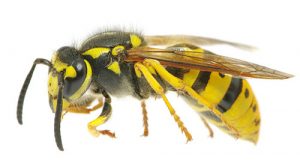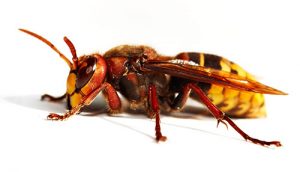Wasps & Hornets
 Wasps have a distinct head with chewing mouth parts, short elbowed antennae, and large compound eyes. The thorax and abdomen are marked with yellow, red or brown on a black background. The wasps have four clear or smokey brown wings and a long stinger. Yellow jackets are usually marked with bright yellow and black patterns and are about 3/8 to 5/8 inches long. The baldfaced hornet is similar in appearance except that is is white and black and 5/8 to 3/4 inch long. Paper wasps are marked with yellow, brown or red patterns on black and are 5/8 to 3/4 inch long.
Wasps have a distinct head with chewing mouth parts, short elbowed antennae, and large compound eyes. The thorax and abdomen are marked with yellow, red or brown on a black background. The wasps have four clear or smokey brown wings and a long stinger. Yellow jackets are usually marked with bright yellow and black patterns and are about 3/8 to 5/8 inches long. The baldfaced hornet is similar in appearance except that is is white and black and 5/8 to 3/4 inch long. Paper wasps are marked with yellow, brown or red patterns on black and are 5/8 to 3/4 inch long.
While there are many varieties of wasps in Vancouver BC, the most common wasps are yellow jackets, hornets, and paper wasps. The queen is responsible for nest establishment and egg laying. Only one queen is present during most of the season. Most of the colony’s inhabitants are female Workers equipped with stingers. Wasps are fast moving, with with the ability to sting repeatedly. Wasps are typically feared as more people die in North America each year from bee and wasp stings than from all other venomous bites such as snakes and spiders combined.
Family
Vespula maculate (Linnaeus) & Polistes spp.
Scientific Name
Hymenoptere/Vespidae
Biology
Social wasps have large nests containing three types of individuals, or castes: queens, workers, and males. Eggs are laid in the cells of the nest, and the young larvae are fed bits of chewed up meat or insect parts by the queen and later by the workers.
Behaviour
Yellow jackets and hornets build flat paper nests in stacks which are then surrounded by a paper envelope. Yellow jackets usually build their nests below ground and in other locations. Baldfaced hornets prefer to build their nests in trees and on the sides of buildings.
Paper wasps build open flat nests, without a paper envelope, usually under the eaves of a house and in other protected locations. Social wasps use their nests only one season. The colonies can contain as many as 30 000 individuals. These insects are considered to be beneficial because they feed their young a variety of insects. They become a nuisance when they build nests in or near structures frequented by humans.
Control & Prevention
 Depending on the species, wasps will build their nests in trees, under roofs and eaves, in sheds and garages, and on decks, porches, and railings. Wasps will aggressively defend a nest under attack.
Depending on the species, wasps will build their nests in trees, under roofs and eaves, in sheds and garages, and on decks, porches, and railings. Wasps will aggressively defend a nest under attack.
Wasp venom, like bee venom, can be a serious risk to health if an allergy is present. Unlike bees, however, wasps can sting without provocation and repeatedly, without any adverse effects to the insect. Even when an allergic reaction doesn’t take place, wasp stings can be extremely painful.
Removing a wasp’s nest can be a difficult and risky undertaking. If you find one on or near your home, call the experts at Nikol Pest Control for safe removal methods
Our technician will inject insecticide into the nest to kill all stages of wasps within the nest. We ask that you stay away from the area for 24 hours after treatment. Please note: do not seal the hole of active wasp nests. Once the nest has been exterminated and you are sure it is inactive, it is OK to then seal the hole.
Other things to remember:
- Strong perfumes and colognes will attract bees and wasps.
- Pick up fallen fruit under fruit trees if possible.
- Keep garbage cans and bins washed
Need help with Wasps & Hornets prevention?
Call Nikol Pest Control at 604-364-3201 for a free estimate.

